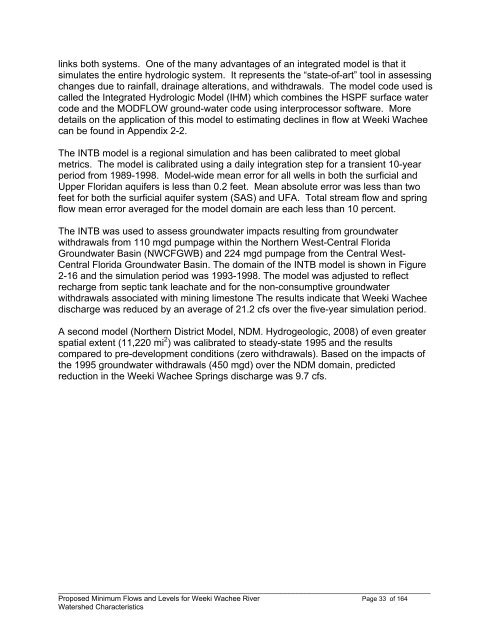Weeki Wachee River System Recommended Minimum Flows and ...
Weeki Wachee River System Recommended Minimum Flows and ...
Weeki Wachee River System Recommended Minimum Flows and ...
Create successful ePaper yourself
Turn your PDF publications into a flip-book with our unique Google optimized e-Paper software.
links both systems. One of the many advantages of an integrated model is that it<br />
simulates the entire hydrologic system. It represents the “state-of-art” tool in assessing<br />
changes due to rainfall, drainage alterations, <strong>and</strong> withdrawals. The model code used is<br />
called the Integrated Hydrologic Model (IHM) which combines the HSPF surface water<br />
code <strong>and</strong> the MODFLOW ground-water code using interprocessor software. More<br />
details on the application of this model to estimating declines in flow at <strong>Weeki</strong> <strong>Wachee</strong><br />
can be found in Appendix 2-2.<br />
The INTB model is a regional simulation <strong>and</strong> has been calibrated to meet global<br />
metrics. The model is calibrated using a daily integration step for a transient 10-year<br />
period from 1989-1998. Model-wide mean error for all wells in both the surficial <strong>and</strong><br />
Upper Floridan aquifers is less than 0.2 feet. Mean absolute error was less than two<br />
feet for both the surficial aquifer system (SAS) <strong>and</strong> UFA. Total stream flow <strong>and</strong> spring<br />
flow mean error averaged for the model domain are each less than 10 percent.<br />
The INTB was used to assess groundwater impacts resulting from groundwater<br />
withdrawals from 110 mgd pumpage within the Northern West-Central Florida<br />
Groundwater Basin (NWCFGWB) <strong>and</strong> 224 mgd pumpage from the Central West-<br />
Central Florida Groundwater Basin. The domain of the INTB model is shown in Figure<br />
2-16 <strong>and</strong> the simulation period was 1993-1998. The model was adjusted to reflect<br />
recharge from septic tank leachate <strong>and</strong> for the non-consumptive groundwater<br />
withdrawals associated with mining limestone The results indicate that <strong>Weeki</strong> <strong>Wachee</strong><br />
discharge was reduced by an average of 21.2 cfs over the five-year simulation period.<br />
A second model (Northern District Model, NDM. Hydrogeologic, 2008) of even greater<br />
spatial extent (11,220 mi 2 ) was calibrated to steady-state 1995 <strong>and</strong> the results<br />
compared to pre-development conditions (zero withdrawals). Based on the impacts of<br />
the 1995 groundwater withdrawals (450 mgd) over the NDM domain, predicted<br />
reduction in the <strong>Weeki</strong> <strong>Wachee</strong> Springs discharge was 9.7 cfs.<br />
____________________________________________________________________________________________<br />
Proposed <strong>Minimum</strong> <strong>Flows</strong> <strong>and</strong> Levels for <strong>Weeki</strong> <strong>Wachee</strong> <strong>River</strong> Page 33 of 164<br />
Watershed Characteristics
















